Macedonian vs Turkish Community Comparison
COMPARE
Macedonian
Turkish
Social Comparison
Social Comparison
Macedonians
Turks
8,797
SOCIAL INDEX
85.4/ 100
SOCIAL RATING
47th/ 347
SOCIAL RANK
9,373
SOCIAL INDEX
91.2/ 100
SOCIAL RATING
17th/ 347
SOCIAL RANK
Turkish Integration in Macedonian Communities
The statistical analysis conducted on geographies consisting of 106,793,376 people shows a mild positive correlation between the proportion of Turks within Macedonian communities in the United States with a correlation coefficient (R) of 0.388. On average, for every 1% (one percent) increase in Macedonians within a typical geography, there is an increase of 0.119% in Turks. To illustrate, in a geography comprising of 100,000 individuals, a rise of 1,000 Macedonians corresponds to an increase of 118.9 Turks.
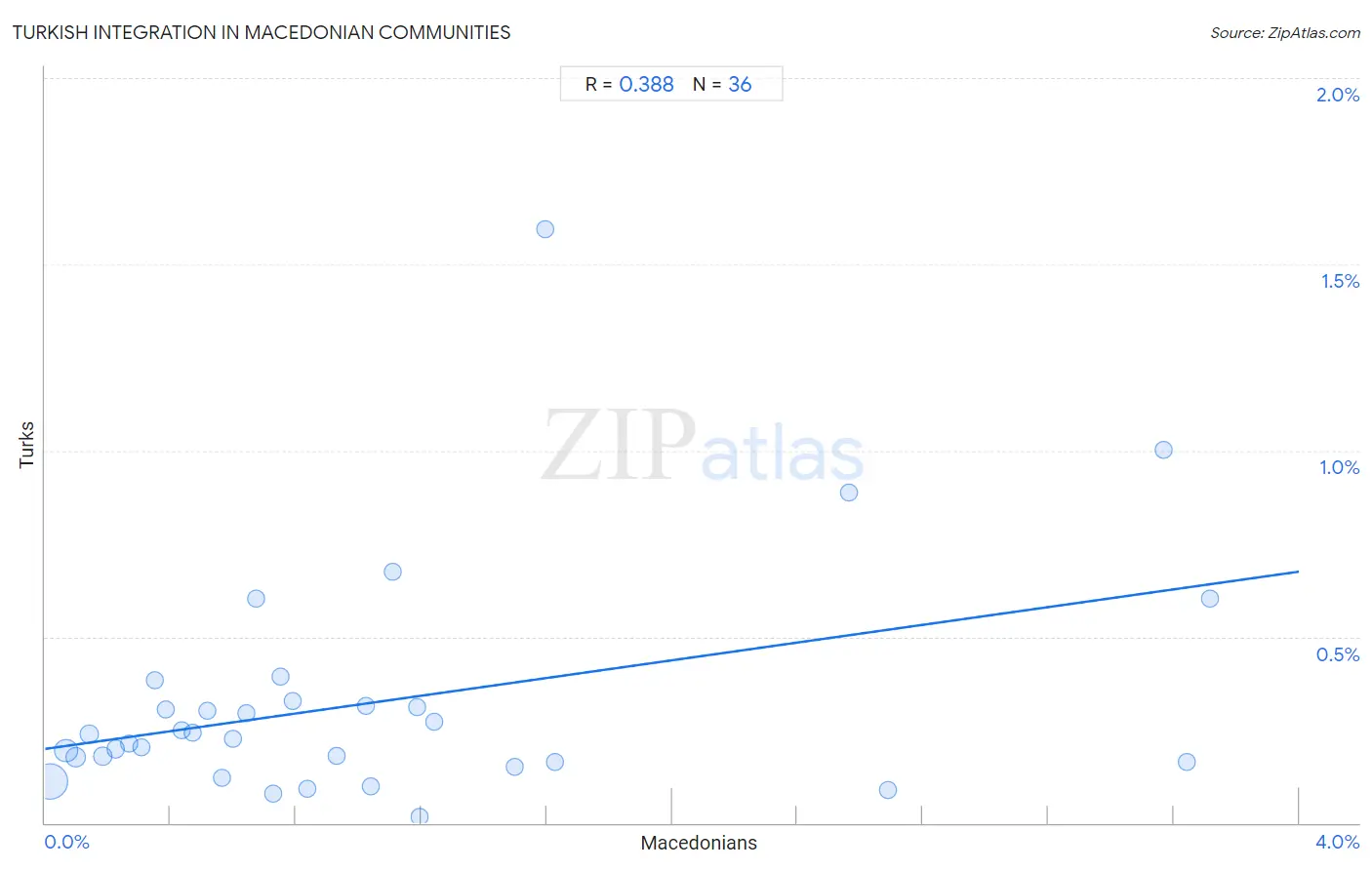
Macedonian vs Turkish Income
When considering income, the most significant differences between Macedonian and Turkish communities in the United States are seen in median family income ($109,668 compared to $121,202, a difference of 10.5%), householder income over 65 years ($61,564 compared to $68,037, a difference of 10.5%), and per capita income ($47,573 compared to $52,391, a difference of 10.1%). Conversely, both communities are more comparable in terms of householder income under 25 years ($54,563 compared to $54,266, a difference of 0.55%), wage/income gap (28.6% compared to 27.7%, a difference of 3.1%), and median male earnings ($59,522 compared to $64,253, a difference of 8.0%).

| Income Metric | Macedonian | Turkish |
| Per Capita Income | Exceptional $47,573 | Exceptional $52,391 |
| Median Family Income | Exceptional $109,668 | Exceptional $121,202 |
| Median Household Income | Exceptional $90,761 | Exceptional $99,389 |
| Median Earnings | Exceptional $49,893 | Exceptional $53,919 |
| Median Male Earnings | Exceptional $59,522 | Exceptional $64,253 |
| Median Female Earnings | Exceptional $41,286 | Exceptional $44,695 |
| Householder Age | Under 25 years | Exceptional $54,563 | Exceptional $54,266 |
| Householder Age | 25 - 44 years | Exceptional $101,882 | Exceptional $110,318 |
| Householder Age | 45 - 64 years | Exceptional $107,074 | Exceptional $117,814 |
| Householder Age | Over 65 years | Good $61,564 | Exceptional $68,037 |
| Wage/Income Gap | Tragic 28.6% | Tragic 27.7% |
Macedonian vs Turkish Poverty
When considering poverty, the most significant differences between Macedonian and Turkish communities in the United States are seen in single father poverty (17.7% compared to 15.8%, a difference of 12.0%), child poverty under the age of 5 (15.8% compared to 14.6%, a difference of 8.5%), and child poverty among boys under 16 (14.7% compared to 13.6%, a difference of 8.1%). Conversely, both communities are more comparable in terms of female poverty (11.8% compared to 11.9%, a difference of 0.38%), poverty (10.8% compared to 11.0%, a difference of 1.5%), and single female poverty (18.9% compared to 18.7%, a difference of 1.5%).
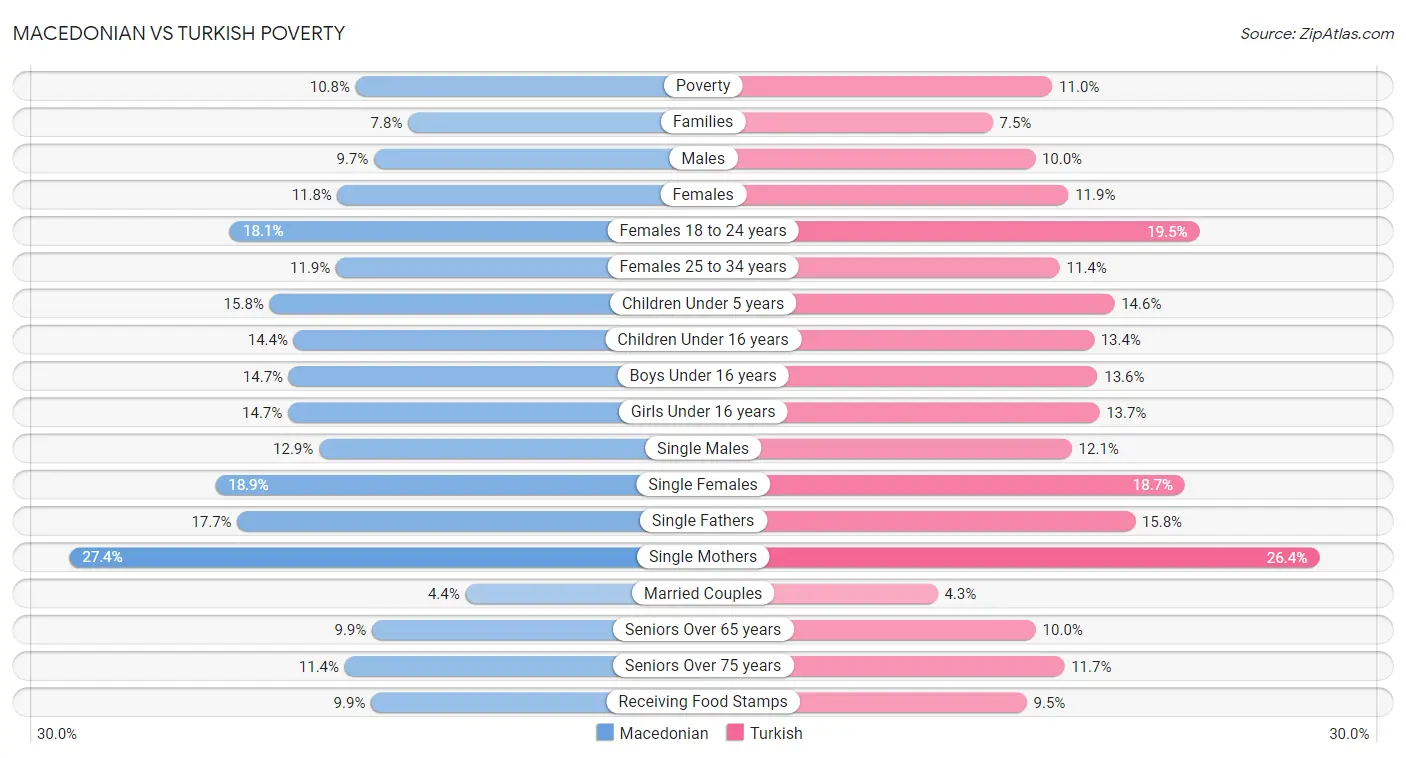
| Poverty Metric | Macedonian | Turkish |
| Poverty | Exceptional 10.8% | Exceptional 11.0% |
| Families | Exceptional 7.8% | Exceptional 7.5% |
| Males | Exceptional 9.7% | Exceptional 10.0% |
| Females | Exceptional 11.8% | Exceptional 11.9% |
| Females 18 to 24 years | Exceptional 18.1% | Exceptional 19.5% |
| Females 25 to 34 years | Exceptional 11.9% | Exceptional 11.4% |
| Children Under 5 years | Exceptional 15.8% | Exceptional 14.6% |
| Children Under 16 years | Exceptional 14.4% | Exceptional 13.4% |
| Boys Under 16 years | Exceptional 14.7% | Exceptional 13.6% |
| Girls Under 16 years | Exceptional 14.7% | Exceptional 13.7% |
| Single Males | Fair 12.9% | Exceptional 12.1% |
| Single Females | Exceptional 18.9% | Exceptional 18.7% |
| Single Fathers | Tragic 17.7% | Exceptional 15.8% |
| Single Mothers | Exceptional 27.4% | Exceptional 26.4% |
| Married Couples | Exceptional 4.4% | Exceptional 4.3% |
| Seniors Over 65 years | Exceptional 9.9% | Exceptional 10.0% |
| Seniors Over 75 years | Exceptional 11.4% | Excellent 11.7% |
| Receiving Food Stamps | Exceptional 9.9% | Exceptional 9.5% |
Macedonian vs Turkish Unemployment
When considering unemployment, the most significant differences between Macedonian and Turkish communities in the United States are seen in unemployment among seniors over 75 years (9.6% compared to 8.6%, a difference of 12.0%), unemployment among ages 30 to 34 years (5.5% compared to 5.1%, a difference of 7.6%), and unemployment among ages 65 to 74 years (5.0% compared to 5.3%, a difference of 7.3%). Conversely, both communities are more comparable in terms of unemployment among ages 60 to 64 years (4.7% compared to 4.8%, a difference of 1.4%), unemployment among women with children under 6 years (7.2% compared to 7.0%, a difference of 1.9%), and female unemployment (5.1% compared to 5.0%, a difference of 1.9%).
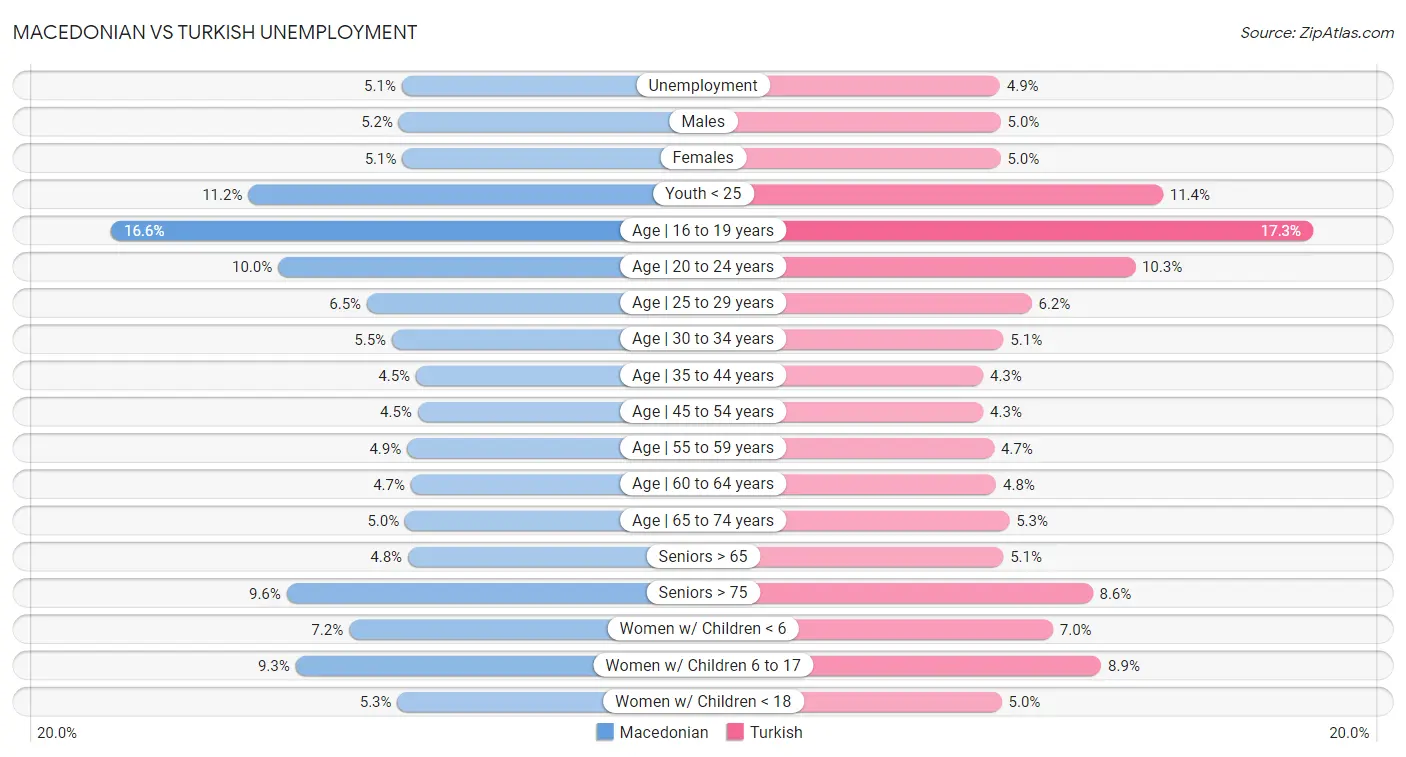
| Unemployment Metric | Macedonian | Turkish |
| Unemployment | Excellent 5.1% | Exceptional 4.9% |
| Males | Good 5.2% | Exceptional 5.0% |
| Females | Exceptional 5.1% | Exceptional 5.0% |
| Youth < 25 | Exceptional 11.2% | Excellent 11.4% |
| Age | 16 to 19 years | Exceptional 16.6% | Good 17.3% |
| Age | 20 to 24 years | Exceptional 10.0% | Average 10.3% |
| Age | 25 to 29 years | Excellent 6.5% | Exceptional 6.2% |
| Age | 30 to 34 years | Average 5.5% | Exceptional 5.1% |
| Age | 35 to 44 years | Excellent 4.5% | Exceptional 4.3% |
| Age | 45 to 54 years | Good 4.5% | Exceptional 4.3% |
| Age | 55 to 59 years | Fair 4.9% | Exceptional 4.7% |
| Age | 60 to 64 years | Exceptional 4.7% | Excellent 4.8% |
| Age | 65 to 74 years | Exceptional 5.0% | Good 5.3% |
| Seniors > 65 | Exceptional 4.8% | Excellent 5.1% |
| Seniors > 75 | Tragic 9.6% | Good 8.6% |
| Women w/ Children < 6 | Exceptional 7.2% | Exceptional 7.0% |
| Women w/ Children 6 to 17 | Tragic 9.3% | Average 8.9% |
| Women w/ Children < 18 | Excellent 5.3% | Exceptional 5.0% |
Macedonian vs Turkish Labor Participation
When considering labor participation, the most significant differences between Macedonian and Turkish communities in the United States are seen in in labor force | age 16-19 (37.8% compared to 35.4%, a difference of 6.7%), in labor force | age 20-24 (76.0% compared to 73.9%, a difference of 2.8%), and in labor force | age > 16 (65.1% compared to 66.1%, a difference of 1.5%). Conversely, both communities are more comparable in terms of in labor force | age 25-29 (85.7% compared to 85.6%, a difference of 0.060%), in labor force | age 20-64 (80.2% compared to 80.3%, a difference of 0.12%), and in labor force | age 35-44 (85.2% compared to 85.1%, a difference of 0.14%).

| Labor Participation Metric | Macedonian | Turkish |
| In Labor Force | Age > 16 | Average 65.1% | Exceptional 66.1% |
| In Labor Force | Age 20-64 | Exceptional 80.2% | Exceptional 80.3% |
| In Labor Force | Age 16-19 | Exceptional 37.8% | Tragic 35.4% |
| In Labor Force | Age 20-24 | Exceptional 76.0% | Tragic 73.9% |
| In Labor Force | Age 25-29 | Exceptional 85.7% | Exceptional 85.6% |
| In Labor Force | Age 30-34 | Exceptional 85.5% | Exceptional 85.7% |
| In Labor Force | Age 35-44 | Exceptional 85.2% | Exceptional 85.1% |
| In Labor Force | Age 45-54 | Exceptional 83.5% | Exceptional 83.8% |
Macedonian vs Turkish Family Structure
When considering family structure, the most significant differences between Macedonian and Turkish communities in the United States are seen in family households with children (26.4% compared to 27.4%, a difference of 3.8%), divorced or separated (11.4% compared to 11.2%, a difference of 1.9%), and single mother households (5.4% compared to 5.5%, a difference of 1.5%). Conversely, both communities are more comparable in terms of family households (63.7% compared to 63.6%, a difference of 0.13%), married-couple households (47.6% compared to 47.8%, a difference of 0.43%), and average family size (3.13 compared to 3.16, a difference of 0.98%).

| Family Structure Metric | Macedonian | Turkish |
| Family Households | Tragic 63.7% | Tragic 63.6% |
| Family Households with Children | Tragic 26.4% | Average 27.4% |
| Married-couple Households | Exceptional 47.6% | Exceptional 47.8% |
| Average Family Size | Tragic 3.13 | Tragic 3.16 |
| Single Father Households | Exceptional 2.0% | Exceptional 2.0% |
| Single Mother Households | Exceptional 5.4% | Exceptional 5.5% |
| Currently Married | Exceptional 48.3% | Exceptional 47.8% |
| Divorced or Separated | Exceptional 11.4% | Exceptional 11.2% |
| Births to Unmarried Women | Exceptional 27.9% | Exceptional 27.4% |
Macedonian vs Turkish Vehicle Availability
When considering vehicle availability, the most significant differences between Macedonian and Turkish communities in the United States are seen in 4 or more vehicles in household (5.5% compared to 5.8%, a difference of 5.8%), no vehicles in household (12.2% compared to 11.7%, a difference of 4.1%), and 3 or more vehicles in household (17.7% compared to 18.4%, a difference of 4.1%). Conversely, both communities are more comparable in terms of 1 or more vehicles in household (87.9% compared to 88.4%, a difference of 0.54%), 2 or more vehicles in household (53.3% compared to 54.3%, a difference of 1.8%), and 3 or more vehicles in household (17.7% compared to 18.4%, a difference of 4.1%).

| Vehicle Availability Metric | Macedonian | Turkish |
| No Vehicles Available | Tragic 12.2% | Tragic 11.7% |
| 1+ Vehicles Available | Tragic 87.9% | Tragic 88.4% |
| 2+ Vehicles Available | Tragic 53.3% | Poor 54.3% |
| 3+ Vehicles Available | Tragic 17.7% | Tragic 18.4% |
| 4+ Vehicles Available | Tragic 5.5% | Tragic 5.8% |
Macedonian vs Turkish Education Level
When considering education level, the most significant differences between Macedonian and Turkish communities in the United States are seen in doctorate degree (1.9% compared to 2.7%, a difference of 42.7%), professional degree (4.8% compared to 6.2%, a difference of 30.5%), and master's degree (16.7% compared to 19.9%, a difference of 19.1%). Conversely, both communities are more comparable in terms of 11th grade (94.1% compared to 94.0%, a difference of 0.030%), nursery school (98.3% compared to 98.2%, a difference of 0.060%), and kindergarten (98.3% compared to 98.2%, a difference of 0.060%).
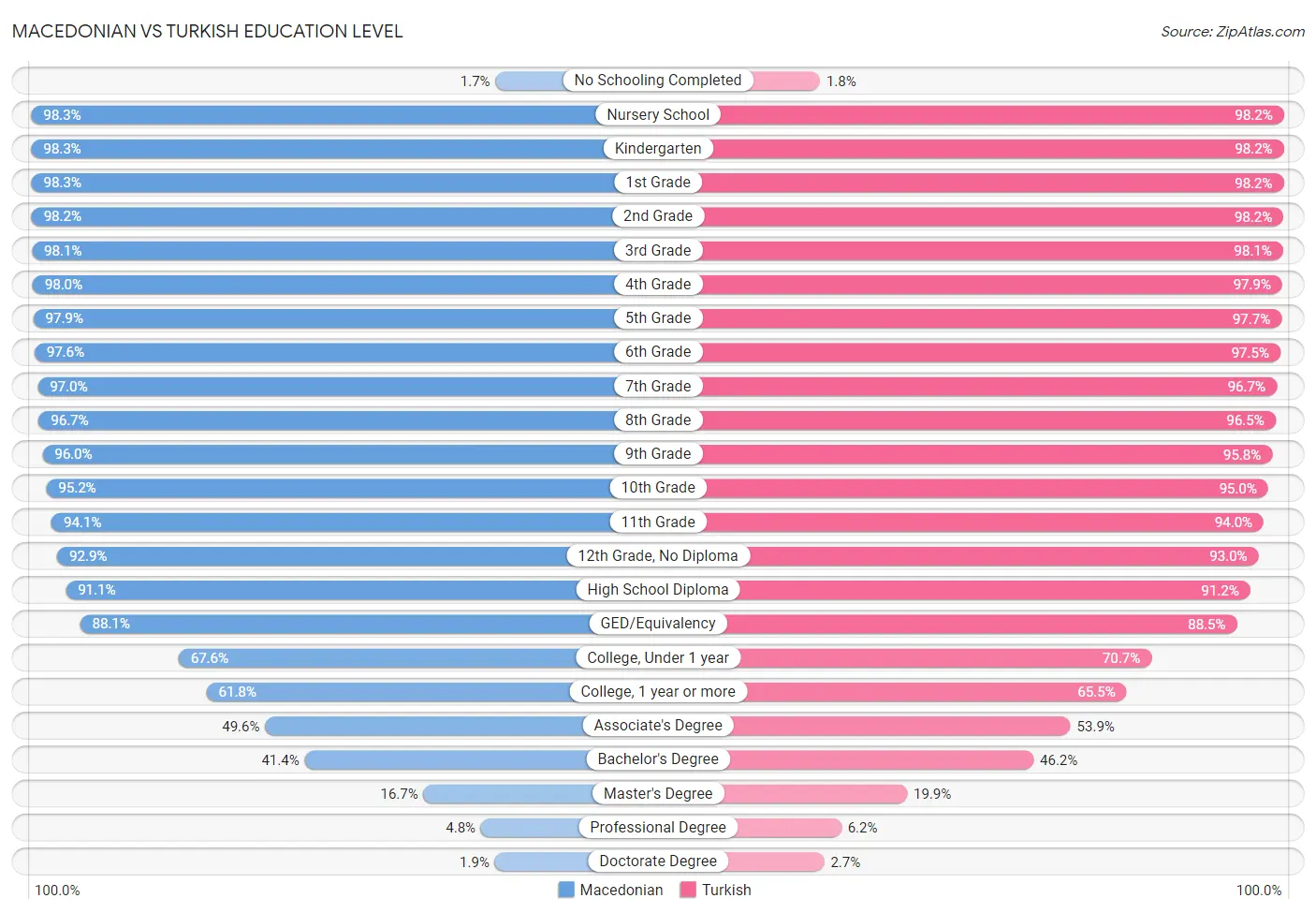
| Education Level Metric | Macedonian | Turkish |
| No Schooling Completed | Exceptional 1.7% | Exceptional 1.8% |
| Nursery School | Exceptional 98.3% | Exceptional 98.2% |
| Kindergarten | Exceptional 98.3% | Exceptional 98.2% |
| 1st Grade | Exceptional 98.3% | Exceptional 98.2% |
| 2nd Grade | Exceptional 98.2% | Exceptional 98.2% |
| 3rd Grade | Exceptional 98.1% | Exceptional 98.1% |
| 4th Grade | Exceptional 98.0% | Exceptional 97.9% |
| 5th Grade | Exceptional 97.9% | Exceptional 97.7% |
| 6th Grade | Exceptional 97.6% | Exceptional 97.5% |
| 7th Grade | Exceptional 97.0% | Exceptional 96.7% |
| 8th Grade | Exceptional 96.7% | Exceptional 96.5% |
| 9th Grade | Exceptional 96.0% | Exceptional 95.8% |
| 10th Grade | Exceptional 95.2% | Exceptional 95.0% |
| 11th Grade | Exceptional 94.1% | Exceptional 94.0% |
| 12th Grade, No Diploma | Exceptional 92.9% | Exceptional 93.0% |
| High School Diploma | Exceptional 91.1% | Exceptional 91.2% |
| GED/Equivalency | Exceptional 88.1% | Exceptional 88.5% |
| College, Under 1 year | Exceptional 67.6% | Exceptional 70.7% |
| College, 1 year or more | Exceptional 61.8% | Exceptional 65.5% |
| Associate's Degree | Exceptional 49.6% | Exceptional 53.9% |
| Bachelor's Degree | Exceptional 41.4% | Exceptional 46.2% |
| Master's Degree | Exceptional 16.7% | Exceptional 19.9% |
| Professional Degree | Excellent 4.8% | Exceptional 6.2% |
| Doctorate Degree | Good 1.9% | Exceptional 2.7% |
Macedonian vs Turkish Disability
When considering disability, the most significant differences between Macedonian and Turkish communities in the United States are seen in disability age under 5 (1.2% compared to 1.1%, a difference of 10.2%), ambulatory disability (6.0% compared to 5.5%, a difference of 9.3%), and hearing disability (3.1% compared to 2.8%, a difference of 8.9%). Conversely, both communities are more comparable in terms of disability age over 75 (45.4% compared to 45.7%, a difference of 0.63%), disability age 65 to 74 (21.3% compared to 21.0%, a difference of 1.4%), and disability age 5 to 17 (5.2% compared to 5.1%, a difference of 1.5%).
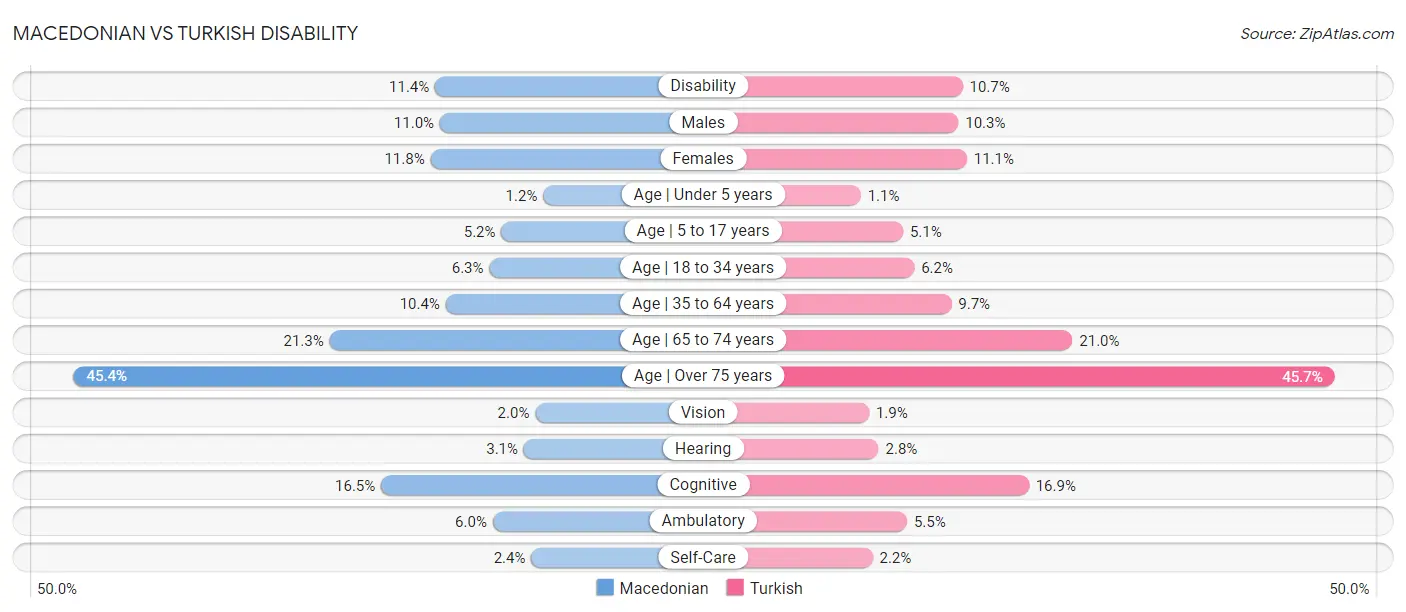
| Disability Metric | Macedonian | Turkish |
| Disability | Exceptional 11.4% | Exceptional 10.7% |
| Males | Excellent 11.0% | Exceptional 10.3% |
| Females | Exceptional 11.8% | Exceptional 11.1% |
| Age | Under 5 years | Average 1.2% | Exceptional 1.1% |
| Age | 5 to 17 years | Exceptional 5.2% | Exceptional 5.1% |
| Age | 18 to 34 years | Exceptional 6.3% | Exceptional 6.2% |
| Age | 35 to 64 years | Exceptional 10.4% | Exceptional 9.7% |
| Age | 65 to 74 years | Exceptional 21.3% | Exceptional 21.0% |
| Age | Over 75 years | Exceptional 45.4% | Exceptional 45.7% |
| Vision | Exceptional 2.0% | Exceptional 1.9% |
| Hearing | Fair 3.1% | Exceptional 2.8% |
| Cognitive | Exceptional 16.5% | Exceptional 16.9% |
| Ambulatory | Excellent 6.0% | Exceptional 5.5% |
| Self-Care | Exceptional 2.4% | Exceptional 2.2% |